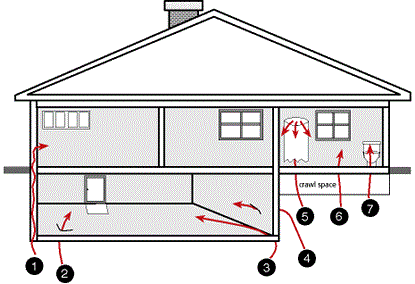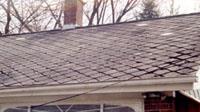Radon & Asbestos
Radon & Asbestos Information
Radon Information
What is Radon?
Radon comes from the natural breakdown of uranium in soil, rock and water. The release of this radioactive gas enters the air you breathe, causing a potential health risk to you and your family. Radon gas can be found in just about anywhere. It can get into any type of building — homes, offices, and schools — and build up to high levels.

Radon is a cancer causing radioactive gas. You cannot see radon and you cannot smell it or taste it, but it may be a problem in your home. This is because when you breathe air-containing radon, you increase your risk of getting lung cancer. In fact, the Surgeon General has warned that radon is the second leading cause of lung cancer.
You should test for radon. Testing is the only way to find out about your home's radon level. The EPA and the Surgeon General recommend testing of all homes below the third floor for radon.
You can fix a radon problem. If you find that you have high radon levels, there are ways to fix a radon problem. Even very high levels can be reduced to acceptable levels.
If you are buying a home. EPA recommends that you obtain the radon level in the home you are considering buying. An EPA publication "The Home Buyer's and Seller's Guide" is available through most State Health Departments or Regional EPA offices listed in your local phone book. EPA also recommends that you use a certified or state licensed radon tester to perform the test. If elevated levels are found it is recommended that these levels be reduced. In most cases, a professional can accomplish this at reasonable cost or homeowner installed mitigation system that adheres to the EPA's approved methods for reduction of radon in a residential structure.
The EPA, Surgeon General and The Center for Disease Control, have all agreed that continued exposure to Radon gas can cause lung cancer. In fact, their position on the matter is that all homes should be tested for radon gas exposure, and all homes testing over 4 pCi/L should be fixed.
Typically the air pressure inside your home is lower than the pressure in the soil around your home's foundation. Due to this difference, your house acts like a vacuum, drawing radon gas in through foundation cracks and other openings of your home. Radon may also be present in well water and can be released into the air in your home when water is used for showering and other household uses.
Potential Entry Points
1.Cavities inside walls
2.Cracks in solid floors
3.Construction joints
4.Cracks in walls
5.The water supply
6.Gaps in suspended floors
7.Gaps around service pipes

Asbestos Information
What Is Asbestos?
Asbestos is a mineral fiber found in rocks, of naturally occurring silicate minerals that can be separated into fibers. There are several kinds of asbestos fibers, all of which are fire resistant and not easily destroyed or degraded by natural processes. The fibers are strong, durable, and resistant to heat and fire. They are also long, thin and flexible, so that they can even be woven into cloth, because of these qualities, asbestos has been used in thousands of consumer, industrial, maritime, automotive, scientific and building products.

During the twentieth century, some 30 million tons of asbestos have been used in industrial sites, homes, schools, shipyards and commercial buildings in the United States. There are several types of asbestos fibers, of which three have been used for commercial applications: (1) Chrysotile, or white asbestos, comes mainly from Canada, and has been very widely used in the US. It is white-gray in color and found in serpentine rock. (2) Amosite, or brown asbestos, comes from southern Africa. (3) Crocidolite, or blue asbestos, comes from southern Africa and Australia.
Asbestos has been shown to cause cancer of the lung and stomach according to studies of workers and others exposed to asbestos. There is no level of exposure to asbestos fibers that experts can assure is completely safe. Some asbestos materials can break into small fibers which can float in the air and these fibers can be inhaled. The tiny fibers are so small they can not be seen with the naked eye. They can pass through the filters of normal vacuum cleaners and get back into the air. Once inhaled, asbestos fibers can become lodged in tissue for a long time. After many years cancer or mesothelioma can develop.
No. A health risk exists only when asbestos fibers are released from the material or product. Soft, easily crumbled asbestos containing material has the greatest potential for asbestos release and therefore has the greatest potential to create health risks.
No. Most people exposed to small amounts of asbestos do not develop any related health problems. Health studies of asbestos workers and others, however, show that the chances of developing some serious illnesses, included lung cancer, are greater after exposure to asbestos.
What is common to many asbestos-containing products is that they were (are) used to contain heat (i.e. thermal insulation.) This was the main reason for their use. It is impossible to list all of the products that have, at one time or another, contained asbestos. One of the most common products asbestos is found in, is in the insulation material found on heating pipes and ducts of homes built before 1960.
Some of the other common asbestos-containing products are insulating cement, insulating block, asbestos cloth, gaskets, packing materials, thermal seals, refractory and boiler insulation materials, transite board, asbestos cement pipe, fireproofing spray, joint compound, vinyl floor tile, ceiling tile, mastics, adhesives, coatings, acoustical textures, duct & pipe insulation for heating, ventilation and air conditioning (HVAC) systems, roofing products, insulated electrical wire and panels, and brake and clutch assemblies.
People who have frequently worked with asbestos (such as plumbers, building contractors or heating contractors) often are able to make a reasonable judgment about whether or not a material contains asbestos on a visual inspection. Many professional home inspectors also can make a reasonable visual judgment. To be absolutely certain, an industrial hygienist would have to make the identification.
Some of the other common asbestos-containing products are insulating cement, insulating block, asbestos cloth, gaskets, packing materials, thermal seals, refractory and boiler insulation materials, transite board, asbestos cement pipe, fireproofing spray, joint compound, vinyl floor tile, ceiling tile, mastics, adhesives, coatings, acoustical textures, duct & pipe insulation for heating, ventilation and air conditioning (HVAC) systems, roofing products, insulated electrical wire and panels, and brake and clutch assemblies.

When it is necessary to disturb asbestos, you should contact a licensed asbestos contractor. You can also obtain a copy of Asbestos in the Home published by the U.S. Consumer Products Safety Commission (800-638-2772) which discusses the situation and makes recommendations. Remember, do not dust, sweep, or vacuum particles suspected of containing asbestos fibers

